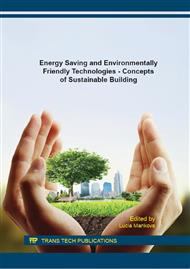p.403
p.411
p.421
p.429
p.437
p.445
p.453
p.461
p.469
High-Tech Solutions for Building Retrofit: Investigation of Window Systems with Vacuum Glazing
Abstract:
The retrofit of the historical building stock has gained significance due to energy efficiency requirements in the building sector. Major attention is drawn to windows as they are typically the building components with the highest heat transfer coefficient of the building envelope. Therefore, vacuum glazing is a potential option for improving the thermal performance of casement windows. In this context, specific considerations regarding building physics and heritage protection regulations are required.The present contribution describes the current progress of the research project VIG-SYS-RENO. New double glazing products with durable vacuum layer are emerging on the market. Such developments can be regarded as a major step toward energy-efficient windows with U-values close to conventional opaque building elements. Small thickness and excellent thermal resistance of vacuum insulation glazing renders it an attractive option in thermal retrofit of historical buildings. Vacuum glazing systems could potentially offer a feasible balance between conservation and thermal performance of windows. However, prior to any application, a set of aspects and potential issues have to be assessed and explored. These include: (i) thermal bridging effects in different joint positions, for instance the glass edge seal and the frame & wall joint; (ii) the positioning of tight layers in composite or casement windows; (iii) aspects of structural integrity of windows equipped with vacuum glazing. The present contribution structures the different aspects that need to be considered in utilization of vacuum glazing in thermal retrofit, describes applied evaluation methods, first results of the ongoing research project, and illustrates the influence of various rebate depth and length of the edge seal on thermal transmission of the window.
Info:
Periodical:
Pages:
437-444
Citation:
Online since:
January 2016
Price:
Сopyright:
© 2016 Trans Tech Publications Ltd. All Rights Reserved
Share:
Citation:



